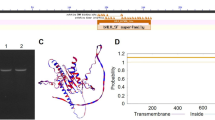Abstract
Oryzain α-A, a cysteine proteinase gene was cloned from rice (Oryza sativa L. cv. Aichi-asahi) leaves infected with Magnaporthe grisea. The protein sequence deduced for oryzain α-A shares high identity with that of oryzain α, a gene expressed in germinating rice seed. Oryzain α-A gene expression was induced by the blast fungus, Magnaporthe grisea, and the transcript level was even higher in the compatible interaction with rice than in the incompatible interaction. Expression of oryzain α-A was also inducible by wounding, ultraviolet radiation, and treatment with salicylic acid and abscisic acid, with no expression induced by methyl jasmonate. The function of oryzain α-A in cell death in rice is discussed.


Similar content being viewed by others
References
Avrova AO, Stewart HE, De Jong WD, Heilbronn J, Lyon GD, Birch PR (1999) A cysteine protease gene is expressed early in resistant potato interactions with Phytophthora infestans. Mol Plant Microbe Interact 12:1114–1119
Birkenmeier FG, Ryan AC (1998) Wound signaling in tomato plants, evidence that ABA is not a primary signal for defense gene activation. Plant Physiol 117:687–693
Bode W, Huber R (1992) Natural protein proteinase inhibitors and their interaction with proteinases. Eur J Biochem 204:433–451
Cervantes E, Rodriguez A, Nicolas G (1994) Ethylene regulates the expression of a cysteine proteinase gene during germination of chickpea (Cicer arietinum L.). Plant Mol Biol 25:207–715
Chomcznski P, Sacchi N (1987) Single-step method of RNA isolation by acid guanidinium thiocyanate-phenol-chloroform extraction. Anal Biochem 162:156–159
Clarke JD, Volko SM, Ledford H, Ausubel FM, Dong X (2000) Roles of salicylic acid, jasmonic acid, and ethylene in cpr-induced resistance in Arabidopsis. Plant Cell 12:2175–2190
D’Silva I, Porier GG, Heath MC (1998) Activation of cysteine proteases in cowpea plants during the hypersensitive response, a form of programmed cell death. Exp Cell Res 245:389–399
Del Pozo O, Lam E (1998) Caspases and programmed cell death in the hypersensitive response of plants and pathogens. Curr Biol 8:1129–1132
Doarse SH, Narvaez-Vasquez J, Conconi A, Ryan CA (1995) Salicylic acid inhibits synthesis of proteinase inhibitor in tomato leaves induced by systemin and jasmonic acid. Plant Physiol 108:1741–1746
Dong X (1998) SA, JA, ethylene, and disease resistance in plant. Curr Opin Plant Biol 1:316–323
Hammond-Kosack KE, Jones JDG (1996) Resistance gene-dependent plant defense responses. Plant Cell 8:1773–1791
Hao L, Hsiang T, Goodwin PH (2006) Role of two cysteine proteinases in the susceptible response of Nicotiana benthamiana to Colletotrichum destructivum and hypersensitive response to Pseudomonas syringae pv tomato. Plant Sci 170:1001–1009
Herde O, Atzorn R, Fisahn J, Wasternack C, Willmitzer L, Pena-Cortes H (1996) Localized wounding by heat initiates the accumulation of proteinase inhibitor II in abscisic cid-deficient plants by triggering jasmonic acid biosynthesis. Plant Physiol 112:853–860
Ho SL, Tong WF, Yu SM (2000) Multiple mode regulation of a cysteine proteinase gene expression in rice. Plant Physiol 122:57–66
Jones JT, Mullet JE (1995) A salt- and dehydration-inducible pea gene, Cyp15a, encodes a cell-wall protein with sequence similarity to cysteine proteases. Plant Mol Biol 28:1055–1065
Jones ML, Larsen PB, Woodson WR (1995) Ethylene-regulated expression of a carnation cysteine proteinase during flower petal senescence. Plant Mol Biol 28:505–512
Koizumi M, Yamaguchi-Shinozaki K, Tsuji H, Shinozaki K (1993) Structure and expression of two genes that encodes distinct drought –inducible cysteine proteinases in Arabidopsis thaliana. Gene 129:175–182
Mikkonen A, Porali I, Cercos M, Ho TH (1996) A major cysteine proteinase, EPB, in germinating barley seeds: structure of two intronless genes and regulation of expression. Plant Mol Biol 31:239–254
Moriyasu Y, Ohsumi Y (1996) Autophagy in tobacco suspension-cultured cells in response to sucrose starvation. Plant Physiol 111:1233–1241
Pena-Cortes H, Prat S, Atzorn R, Wasternack C, Willmitzer L (1996) Abscisic acid-deficient plants do not accumulate proteinase inhibitor II following systemin treatment. Planta 198:447–451
Pena-Cortes H, Sanchez-Serrano JJ, Mertens R, Willmitzer L, Prat S (1989) Abscisic acid is involved in the wound-induced expression of the proteinase inhibitor II gene in potato and tomato. Proc Natl Acad Sci USA 86:9851–9855
Peng YL, Shishiyama J (1988) Temporal sequence of cytological events in rice leaves affected with Pyricularia oryzae. Can J Bot 66:730–735
Sambrook J, Fritsch EF, Maniatis T (1989) Molecular cloning: a laboratory manual, 2nd edn. Cold Spring Harbor, New York
Schaffer MA, Fischer RL (1988) Analysis of mRNAs that accumulate in response to low temperature identifies a thiolprotease in tomato. Plant Physiol 87:431–436
Seo S, Sano H, Ohashi Y (1997) Jasmonic acid in wound signal-transduction pathways. Physiol Plant 101:740–745
Shirasu K, Nakajima H, Rajasekhar VK (1997) Salicylic acid potentiates an agonist-dependent gain control that amplifies pathogen signals in the activation of defense mechanisms. Plant Cell 9:261–270
Thomma BPHJ, Eggermont K, Penninckx IAMA, Mauch-Mani B, Vogelsang R, Cammue BPA, Broekaert WF (1998) Separate jasmonate-dependent and salicylate-dependent defense-response pathways in Arabidopsis are essential for resistance to distinct pathogens. Proc Natl Acad Sci USA 95:15107–15111
Thornberry NA, Lazebnik Y (1998) Caspases: enemies within. Science 281:1312–1316
Valent B, Chumley FG (1991) Molecular genetic analysis of the rice blast fungus, Magnapothe grisea. Annu Rev Phytopathol 29:443–467
Wasternack C, Parthier B (1997) Jasmonate-signaled plant gene expression. Trends Plant Sci 2:302–307
Watanabe H, Abe K, Emori Y, Hosoyama H, Arai S (1991) Molecular cloning and gibberellin-inducible expression of multiple cysteine proteinases of rice seeds (oryzains). J Biol Chem 266:16897–16902
Wu CX, Zhou SY, Zhang Q, Zhao WS, Peng YL (2006) Molecular cloning and differential expression of a γ-aminobutyrate transaminase gene, OsGABA-T, in rice (Oryza sativa) leaves infected with blast fungus. J Plant Res 119:663–669
Acknowledgments
This research was supported by the National Basic Research Program of China (973 Program) 2006CB101905. We thank Dr. Tom Hsiang of the University of Guelph, Canada, for his editorial assistance.
Author information
Authors and Affiliations
Corresponding author
Rights and permissions
About this article
Cite this article
Fu, Y., Zhao, W. & Peng, Y. Induced expression of oryzain α gene encoding a cysteine proteinase under stress conditions. J Plant Res 120, 465–469 (2007). https://doi.org/10.1007/s10265-007-0080-5
Received:
Accepted:
Published:
Issue Date:
DOI: https://doi.org/10.1007/s10265-007-0080-5




